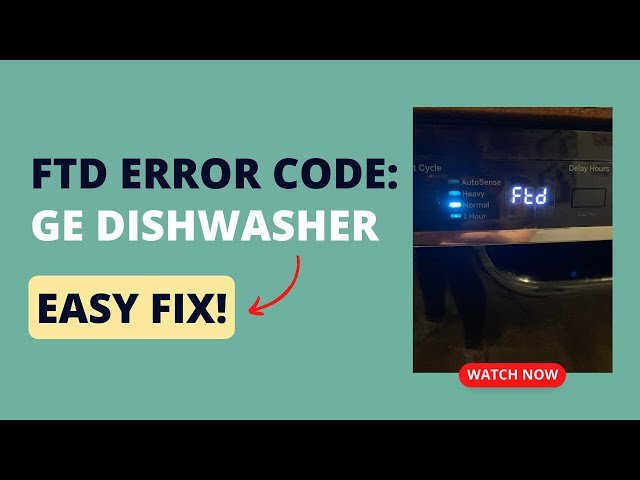
When we see error codes, they often seem like cryptic messages. Like trying to understand a toddler who’s just learned to talk, you’re left scratching your head and wondering what on earth it means. With GE dishwashers, the E1 error code typically signals a problem with water drainage. This could be due to a variety of reasons, but the core message is simple: your dishwasher isn’t draining the water properly. Ignoring this code could be like ignoring a leaky pipe under your sink—it might start as a small drip, but could lead to a big mess later. Let’s unravel this mystery, step by step, so you’re armed with the info you need!
Understanding Error Code E1
So, what exactly is Error Code E1 trying to tell us? Think of your dishwasher as a mini car wash for your dishes. It needs to bring in water, swish it around to clean, and then drain it out. If any part of this process gets interrupted, the dishwasher throws up an error code to alert you. The E1 code specifically relates to an issue in the draining process. You see, when water isn’t draining as it should, it’s not just water sitting at the bottom—it’s dirty water filled with food particles. It’s like trying to take a bath in water you’ve already used; not very pleasant, right?
Several factors could cause the water drainage problem. It might be a clogged drain hose, a kink in the line, or even a problem with the dishwasher’s pump. These aren’t just technical terms—they’re like the veins and arteries of your dishwasher’s heart. If they’re blocked or malfunctioning, the whole system doesn’t work efficiently. Essentially, if you notice error code E1, it’s your machine’s way of pleading, “Please, help me drain better!”
Ignoring this isn’t a great idea, and here’s why: the longer the water sits, the more it risks developing mold or bacteria. Plus, it’s not doing your dishes any favors in the cleanliness department. So, taking a moment to investigate can save you from a bigger headache down the line.
Causes of Error Code E1
Now, you might be wondering, “Why does this happen to my trusty dishwasher?” Well, think of it like your dishwasher catching a cold. Sometimes, it’s due to everyday reasons, like age—older dishwashers, much like older cars, might have more quirks. The most common cause is a blocked or clogged drainage hose. Picture a garden hose with a knot in it; water just can’t flow through smoothly. Similarly, food scraps, grease, and grime can build up and create a clog.
Another potential culprit is the pump. This is the part responsible for pushing the water out of the dishwasher, kind of like the engine in your car propelling it forward. If the pump’s faulty, water isn’t going anywhere. And then there’s the issue of the drain filter. It’s there to catch larger debris, but if not cleaned regularly, it can become a blockage itself. It’s like putting a strainer in your sink—eventually, it needs cleaning.
Understanding these causes helps you pinpoint where the problem might lie. You don’t need a mechanic’s level of expertise, but a basic understanding goes a long way in identifying potential issues.
Dealing with Error Code E1
Okay, we’ve established what Error Code E1 is and what might cause it. But what do you actually do if it pops up on your display? First things first, let’s get hands-on. Remember to turn off the power to your dishwasher—safety first! Then, take a look at the drain hose. If it’s kinked or clogged, straighten it out or give it a good clean. Sometimes, just ensuring the path is clear solves the issue.
Next, examine the filter. It’s usually located at the bottom of your dishwasher. Remove any visible debris. It’s like cleaning out the laundry lint trap—a simple step that makes a big difference. If you suspect the pump, it might be time to call in a professional. Think of them as the “dishwasher doctors”—they have the tools and expertise to fix things without guesswork.
If you’ve tried these steps and the code still flashes, don’t ignore it. Persistent issues can lead to more problems, like flooding. Addressing the error promptly ensures your dishwasher runs smoothly and keeps your kitchen in tip-top shape. Plus, it saves you from hand-washing dishes—a win in anyone’s book!
Preventing Future Error Codes
So, how do you keep your dishwasher from flashing that frustrating E1 code in the future? It’s all about maintenance, much like how regular oil changes keep your car running smoothly. Start by being mindful of what goes into your dishwasher. Scrape off large food pieces before loading your dishes. Your dishwasher’s filters are not garbage disposals—they need a little help from you.
Make cleaning the filter a routine chore. Every month or so, take a moment to remove and rinse it. This small step ensures there’s nothing to impede the water flow. Also, keep an eye on your dishwasher’s performance. If you notice it’s not draining as quickly, take a proactive approach. Just like noticing your car pulls to one side before it becomes an issue, catching problems early can save a lot of time and trouble.
Lastly, consider running a dishwasher cleaner through your machine every few months. It’s like a spa day for your dishwasher, clearing out build-up and keeping everything smelling fresh. By following these preventative tips, you can enjoy hassle-free dishwashing without the worry of error codes interrupting your day.
In summary, while it might be tempting to ignore Error Code E1, doing so can lead to bigger issues down the line. With a little detective work and regular maintenance, you can keep your dishwasher in top shape and avoid those pesky codes from popping up in the first place.